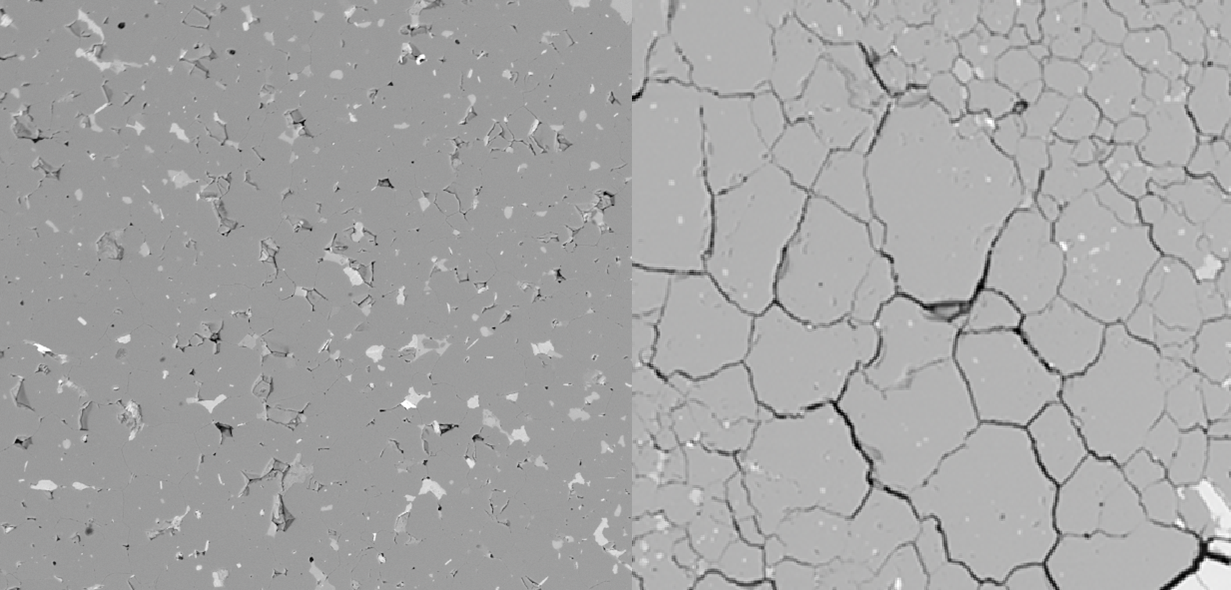Researchers from the University of Tokyo revealed how concrete's properties impact its structural qualities under various neutron radiation loads. Their research raises some issues while lowering others. For instance, concrete's self-healing quartz crystals may enable some reactors to operate longer than previously believed. The Journal of Nuclear Materials published the study.
 Cracking crystals. An image from a scanning electron microscope of Metachert aggregate, a concrete analog, before exposure to neutron radiation (left) and after (right). Image Credit: 2025 Maruyama et al.
Cracking crystals. An image from a scanning electron microscope of Metachert aggregate, a concrete analog, before exposure to neutron radiation (left) and after (right). Image Credit: 2025 Maruyama et al.
The effects of radiation on concrete's structural integrity have long been recognized, but the specifics of this were unknown until now.
Certain high-profile nuclear power plant incidents naturally alarmed people. However, many people think that nuclear power is one of the main pillars of reaching a carbon-neutral world.
Finding methods to enhance safety, dependability, affordability, and other aspects is prioritized to allay concerns and boost acceptance of this technology. The materials used in the construction of nuclear power plants, particularly the concrete used throughout the buildings, are one factor that affects both longevity and safety.
Concrete has long been researched to better understand its material properties and is known to be very robust. However, researchers have only recently thoroughly investigated the effects of neutron radiation from nuclear reactors on the durability of concrete.
Concrete is a composite material made up of multiple compounds. These can vary depending on various factors, including local geography, especially the rock aggregate which is a major component in concrete. But rock will often contain quartz. So, understanding how quartz changes under different radiation loads can help us predict how concrete should also behave in general.
Ippei Maruyama, Professor, Department of Architecture, University of Tokyo
Maruyama said, “Neutron radiation-induced degradation is a particularly costly area of study, making extensive research difficult. Our research team has been addressing this issue since 2008, formulating strategies to solve the problem by consulting a wide range of literature and conducting interviews with experts. This culminated in our recent experiments using X-ray diffraction to look at irradiated quartz crystals.”
Maruyama and his group examined two characteristics of neutron radiation: the overall dose received by the samples and the flux, or rates at which the dose is received. At first, their findings were a little unexpected.
For a given total dosage of neutron radiation, a quartz crystal's expansion increased significantly with a higher dose rate, and vice versa. People could use the sun's effects on their skin as an example. Avoiding prolonged exposure to direct sunlight without protection is generally recommended, but getting the same exposure over a longer time is less concerning.
“The discovery of the flux effect indicates not only that neutron radiation distorts the crystal structure, causing amorphization and expansion, but that there is also a phenomenon where the distorted crystals recover and the expansion diminishes, hence a lower rate affords more time to heal,” said Maruyama.
We also saw this phenomenon depends on the size of the mineral crystals within concrete. Larger crystal grains exhibited less expansion, suggesting a size-dependent effect. Considering these findings, the degradation of concrete due to neutrons, which is currently a concern, may involve less expansion than previously thought. Consequently, degradation may be less severe than anticipated, potentially allowing nuclear power plants to operate more safely over longer periods.
Ippei Maruyama, Professor, Department of Architecture, University of Tokyo
To better understand the mechanisms of expansion and develop the capacity to forecast aggregate expansion based on material properties and environmental conditions, the team is currently working to address some challenges related to the expansion behavior of various rock-forming minerals.
The team also aims to forecast how cracks will form based on mineral expansion. This research may benefit future nuclear power plant concrete design and material selection. Furthermore, it could offer important information about the stability and longevity of inorganic materials used in space-based construction for extraterrestrial construction in Earth's orbit and beyond.
Journal Reference:
Maruyama, I., et al. (2025) Neutron flux impact on rate of expansion of quartz. Journal of Nuclear Materials. doi.org/10.1016/j.jnucmat.2025.155631.